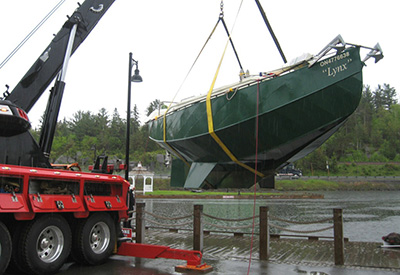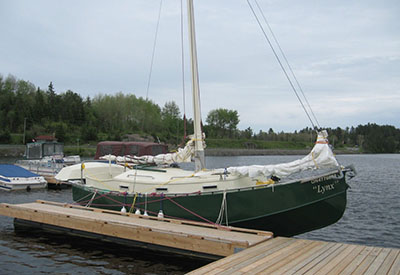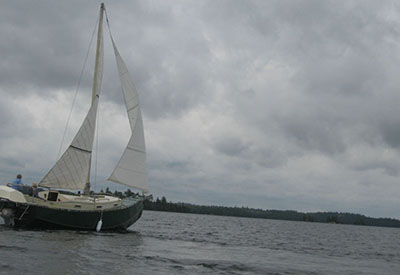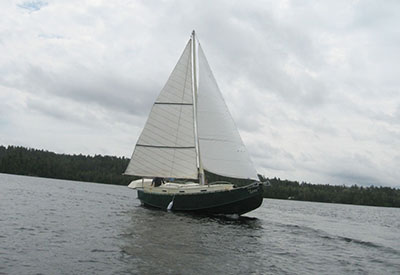The Launching of “Lynx”

July 25, 2017
On June 5, 2017, the 26-foot steel sloop “Lynx” was launched after eight years of part-time building.
The project first started, you could say, over 50 years ago, when I had the opportunity to work in a boat building shop during my summer between high school and college.
The shop, located on Chesapeake Bay, was owned and operated by Tom Colvin. He is considered to be the father of steel and aluminum sailboat design and construction and wrote what most people agree is the bible on building in these materials. His designs are known for being simple, seaworthy, and based on traditional ideas from the days of working sailing ships. His vessels have probably logged more actual ocean mileage than any other designer in modern times.
 During that summer I considered it an interesting job, but at the time never thought of owning or building a sailboat of my own. However, over the years, working as a carpenter and welder, the idea of building a boat was always lurking somewhere in the deep recesses of my mind.
During that summer I considered it an interesting job, but at the time never thought of owning or building a sailboat of my own. However, over the years, working as a carpenter and welder, the idea of building a boat was always lurking somewhere in the deep recesses of my mind.
A number of years were spent on the west coast of British Columbia where I had a chance to sail on many different boats, and worked in the field of boat repair on both commercial and pleasure vessels, in wood, steel, aluminum and fiberglass.
 When I was 60 years old, I decided it was now or never. At the time my wife Mari and I were living about a seven hour drive north of Winnipeg, Manitoba, near the town of The Pas. I had first designed and made a half model of a 32-foot schooner and had actually fabricated the keel. The boat was to be of double chine steel with a long, shallow keel with two small bilge keels.
When I was 60 years old, I decided it was now or never. At the time my wife Mari and I were living about a seven hour drive north of Winnipeg, Manitoba, near the town of The Pas. I had first designed and made a half model of a 32-foot schooner and had actually fabricated the keel. The boat was to be of double chine steel with a long, shallow keel with two small bilge keels.
At this point it became obvious to me that with a limited budget and working outside part-time in the summers, it was quite possible such a large boat might never be finished. So, back to the drawing board. The design finally settled on was to be of 24-foot waterline, 26 feet on deck, double chine with bilge keels, cat rigged, outboard powered, and built of steel. Of about 10,000 lbs. displacement, the general hull design is of a very fine, long bow, sweeping into a very beamy mid-section of ten feet.
 The keel was then fabricated, which was actually shortened from the 32-foot one already started. Next the frames were set up, and the chine pieces installed. We decided to move to Northern Ontario, so along with all our other possessions, the keel and framework were disassembled and transported by trailer.
The keel was then fabricated, which was actually shortened from the 32-foot one already started. Next the frames were set up, and the chine pieces installed. We decided to move to Northern Ontario, so along with all our other possessions, the keel and framework were disassembled and transported by trailer.
Keeping in mind all work was to be done outside and part-time during the summers only, as snow is on the ground here about six months of the year.
So the general design goals were to be of a small, simple, seaworthy, relatively inexpensive boat with which one or two people could contemplate an ocean voyage. With a long, shallow keel of about four feet draft.
During the actual construction, as often happens, some design specifications were changed or might be changed if another boat of this model was ever to be built.
The hull and decks were of steel, but the cockpit, cabin sides and roof were built of laminated plywood. In retrospect, it might have been simpler to build everything out of steel, including the cabin and cockpit. In building the rig, I wimped-out in regards to the cat rig, and went to a sloop instead. I think this was probably a wise decision.
The mast is fixed to a massive tabernacle on the cabin roof, supported by a heavy beam running to the keel. Theoretically this is a much more simple way to step the master, but in practice it’s still a lot of work. I think a one-piece mast stepped on the keel might have been the better way to go.
The draft, surprisingly, came in at about 3 ½ instead of 4 feet. Time will tell if I need to add more ballast, as sea trials have just began. So far, in moderate winds, it seems to be adequately stable, and that shallow draft has already come in handy. By the way, the mainsail has two full length battens and two reef points; the jib also has two reef points. I am a strong believer in the practice of reefing, something most modern designers and sailors have forgotten about. And don’t talk to me about “roller” reefing. In my experience such a complicated and expensive device will surely fail just when you need it the most.
So there you have it. In the two times I’ve sailed the boat so far, these are my first, tentative impressions. On the hand-held GPS it has hit six miles (not knots) an hour, both under sail and with the 9.9 hp Honda. It seems to track well with no noticeable weather-helm, and turns in a reasonable radius. In moderate winds with full sail, it is not overly tender. And sailing with a long-shallow steel keel with a protected rudder gives a real feeling of confidence, especially with the shallow draft. So… so far, so good. A further report might be of interest after the first full summer of cruising.
Mike Camp
www.mikecampdesigns.ca
June 26, 2017




























